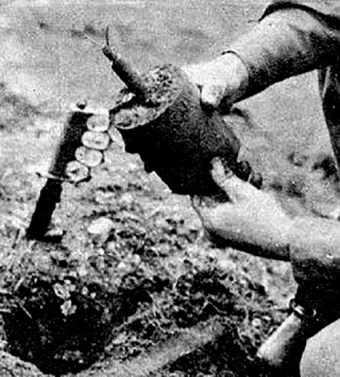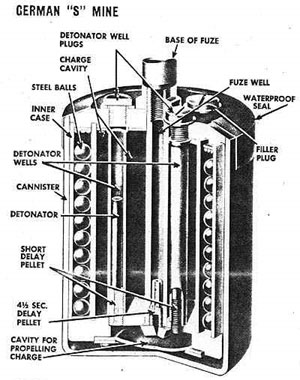The Terrifyingly Effective Nazi “De-Bollocker”
 While landmines have existed as a concept as early as the 13th century when they were used by the Chinese to repel Mongol Invasions, it’s Imperial Germany that is credited with making the advances that led to modern landmines as we understand them. Utilised extensively during WW1 by the Germans, the weapons proved to be so effective that they were rapidly copied and deployed by all the major superpowers involved in the conflict. When Hitler assumed power of Germany in 1933, landmine technology was once again pushed to the forefront of military research. This brings us to the topic of today.
While landmines have existed as a concept as early as the 13th century when they were used by the Chinese to repel Mongol Invasions, it’s Imperial Germany that is credited with making the advances that led to modern landmines as we understand them. Utilised extensively during WW1 by the Germans, the weapons proved to be so effective that they were rapidly copied and deployed by all the major superpowers involved in the conflict. When Hitler assumed power of Germany in 1933, landmine technology was once again pushed to the forefront of military research. This brings us to the topic of today.
Variously called the Schrapnellmine 35 (Shrapnel Mine 35), Splinter-mine, or “Bouncing Betty”, the S-Mine, as it was officially dubbed in Allied memos, was a deceptively simplistic weapon that one Lt. Col. C. E. E. Sloan dubbed “the most feared device encountered by Allied troops in the war.”
Physically, the mine resembled a small cylinder inside of which was either powdered or poured TNT. On top of each mine was a fuse which when sprung caused the explosive inside to detonate. The thing that set the S-mine apart from similar devices was that, rather than exploding immediately, it was designed to explode around four seconds after being tripped. Another key distinguishing feature of the S-mine, and the one that made it so lethally effective, is that instead of detonating in the ground, its fuse was designed to launch the body of the mine about three feet into the air, at which point it would violently explode. To maximise lethality, the body of the S-mine was filled with hundreds of steel ball bearings that would be launched outwards at high speeds.
The capacity for destruction of the S-mine cannot be understated, and while the exact lethal range of the mine isn’t clear, a 1943 US Army Field Manual claimed that it could inflict casualties as far away as 460 feet from the point of detonation.
 That said, perhaps due to their hastily constructed nature (the German Military produced nearly two million of these things during WW2 alone), the quality of the mine varied dramatically. As a result, more often than not the mine would simply severely maim rather than kill outright.
That said, perhaps due to their hastily constructed nature (the German Military produced nearly two million of these things during WW2 alone), the quality of the mine varied dramatically. As a result, more often than not the mine would simply severely maim rather than kill outright.
This is doubly terrifying in a weapon that was explicitly designed to detonate at testicle height. And, in fact, it’s for this exact reason that British soldiers sometimes referred to the S-mine as the “Debollocker” (bollock being slang for testicles). Other similar nicknames adopted by the Allies for the device included “The Bouncing Bitch” or more succinctly, “The Castrator”. However, as noted, the most common name among Allied soldiers for the mine was “The Bouncing Betty”- a name originally coined by American troops.
The first known Allied encounter with the S-mine occurred during the Saar Offensive in 1939, shortly after the start of WW2. German forces mined the region so heavily that a French offensive (yep) into German territory was halted in its tracks… Said soldiers reported the mine’s existence and effectiveness to their superiors along with their own personal nickname for it- The Silent Soldier.
As this mine was developed during the Third Reich, records about its origins are understandably hard to come by, but we do know that it was developed sometime in 1935- hence “Schrapnellmine 35”. Throughout the war, Nazi engineers continued to make improvements to the already deadly device, culminating in the creation of a glass version of the mine unimaginatively dubbed the “Glasmine 43” that was developed in- you guessed it- 1943. Along with being largely undetectable to mine detectors of the time, the Glasmine carried an increased risk of infection partially thanks to the fact that the glass shrapnel was harder for X-rays to detect, making operating on a person injured by it that much more difficult.
Beyond German forces planting the S-mines “like grass seed” pretty much everywhere they thought Allied soldiers might come near, they also cleverly peppered S-mines around anti-tank and vehicle mines so that the soldiers inside the vehicles disabled by them would either be killed by the S-mines when exiting the ruined vehicle or have to stay put.
Due to the extreme density of these mines in certain regions, even when particular Allied troops had the ability to detect the mines (which was a big “if” considering mine detecting equipment was in short supply throughout the war), proceeding through mined land was exceptionally difficult and slow-going. At times, this became so bad that progress into certain German-held territory stopped entirely.
As an example of how saturated some areas were with mines, after D-Day (see: What Does the D in D-Day Stand For?), Allies found and removed over 15,000 unexploded mines from the dunes around Pouppeville alone. Further, after WW2 Allied forces conscripted some 49,000 German POWs to remove as many mines as they could throughout Western Europe. Yet even with this massive amount of man-power and meticulously kept Nazi maps of where the mines were planted, there are still areas today, particularly in North Africa and certain parts of Eastern Europe, that are considered unsafe to travel on because there may still be some functional, undetonated WW2-era mines located there.
As you can probably guess given the Bouncing Betty’s brutal effectiveness, the design of the mine was quickly reverse engineered and derivatives were extensively created by numerous countries. However, due to the fact that the devices cause such horrific, debilitating injuries, and a buried, forgotten mine is just as dangerous to your own people as your enemy’s, few countries today still use mines of any design in combat. Notable exceptions to this include Russia and the People’s Republic of China.
Incidentally, beyond being an extremely deadly mine, the Schrapnellmine 35 also gave birth to a common myth about land mines that you’ll often see today in movies- that such mines only detonate when the person who set it off steps off the trigger. This is a myth that became widespread during the war and likely originated due to the fact that the S-mine was made to detonate a few seconds after being triggered, making it appear to not go off until the person stepped away. In reality, the mine was designed to detonate whenever a weight of more than 15 pounds hit the ground anywhere near it.
If you liked this article, you might also enjoy our new popular podcast, The BrainFood Show (iTunes, Spotify, Google Play Music, Feed), as well as:
- The Pivotal WWII Gun That Nobody Wanted to Put Down- The “Plumber’s Nightmare”
- England’s Proposed Secret Weapon- A Massive Ship Made of Ice
- WWII Files: Surprisingly Effective Pigeon-Guided Missiles and Bat Bombs
- The Flying Tank – Antonov A-40
- The Exploding Anti-Tank Dogs of World War II
Bonus Fact:
- Due to the fact that these mines didn’t detonate until they were a few feet in the air and launched out shrapnel at a mostly horizontal angle, injury from S-mines could sometimes be avoided by immediately laying down once the mine was triggered.
| Share the Knowledge! |
|





“That said, perhaps due to their hastily constructed nature (the German Military produced nearly two million of these things during WW2 alone), the quality of the mine varied dramatically. As a result, more often than not the mine would simply severely maim rather than kill outright.”
I would argue that the mines were properly made. Injuring the enemy puts a strain on logistics – 2 to 4 guys to carry off every casualty, medical facilities inundated with wounded, etc – whereas dead guys just lie there and the unit continues on.
“However, due to the fact that the devices cause such horrific, debilitating injuries, and a buried, forgotten mine is just as dangerous to your own people as your enemy’s, few countries today still use mines of any design in combat. Notable exceptions to this include Russia and the People’s Republic of China.”
The U.S. also still uses land mines and refuses to sign the Mine Ban Treaty.
Speedily turning sideways would minimise risk of injury if one was triggered a few yards away – just as turning sideways in a gunfight or duel limits the available target?
“However, due to the fact that the devices cause such horrific, debilitating injuries, and a buried, forgotten mine is just as dangerous to your own people as your enemy’s, few countries today still use mines of any design in combat. Notable exceptions to this include Russia and the People’s Republic of China.”
Wrong. The three biggest producers and users of land mines (not coincidentally, the only three remaining world powers) are the USA, Russia and Red China, and none of them wants anything to do with the Land Mine Ban because they know how useful landmines can be. This ensures millions of US/Russian/Chinese mines end up on both the open and black markets every year, freely available to those with the cash.
Thus, the meaningless UN sponsored ban is mostly a “feel good” gesture that allows small, weak, and militarily irrelevant nations to score PR benefits and negotiation chits by “signalling virtue” in the landmine debate; by symbolically refusing to make or stock land mines (which is no great loss), they preserve the ability to acquire and emplace a wide variety of easily-acquirable mines from Russia/China/the US within days if they chose to do so. Thus they’ve lost nothing and gained the famous “moral high ground” that Leftists are so enamored of.
Read less Princess Diana & more Carl von Clausewitz.